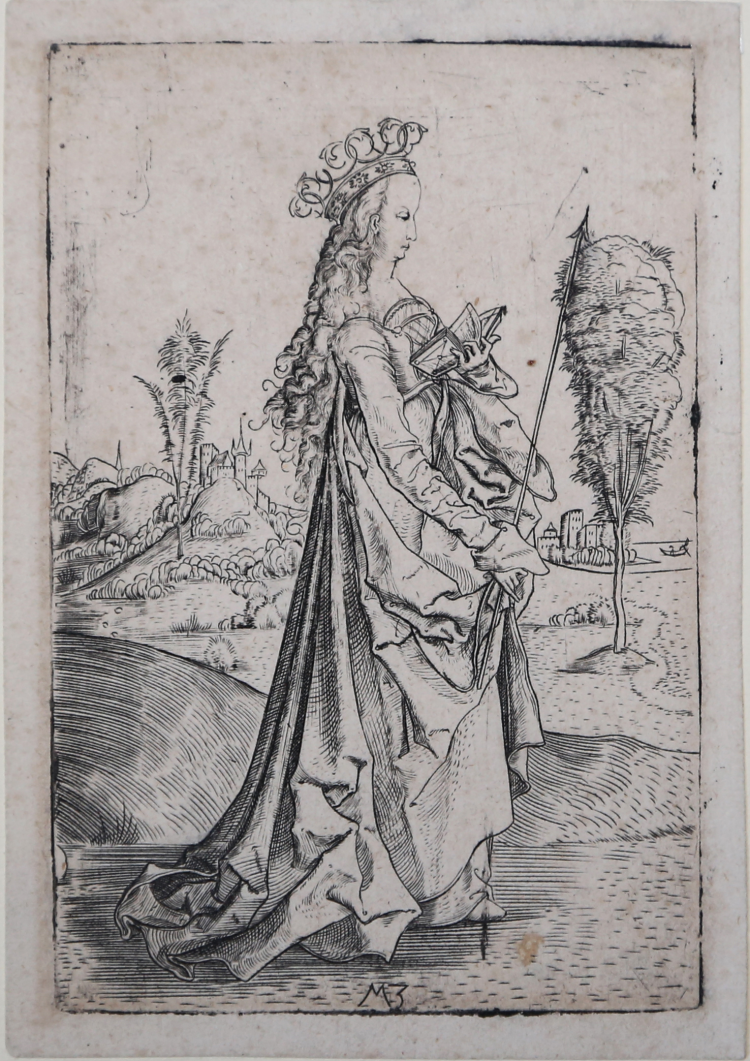




| Reference: | S5273 |
| Author | Martin ZASINGER (Maestro MZ) |
| Year: | 1500 ca. |
| Measures: | 86 x 129 mm |



| Reference: | S5273 |
| Author | Martin ZASINGER (Maestro MZ) |
| Year: | 1500 ca. |
| Measures: | 86 x 129 mm |
St Ursula; the saint stands within a landscape, turned to the right, holding a book and arrow.
Engraving, 1500 circa, signed, at lower centre, with the monogram “MZ”.
Good example, printed on contemporary laid paper, occasional light stain, otherwise in good condition.
The "St. Ursula," "St. Margaret", and "St. Catherine" series are similar in size and format and represent three virginal noble- women martyred their faith. St. Ursula thought to have been slain by pagan archers at Cologne, for which reason her attribute is an arrow Mojzer (1975, pp. 399-400) has suggested a date of 1500 for all three female saints, and has noted the influence of Schongauer's The Second Wise Virgin" (TIB 8, 78 [154], p. 281) and "The First Foolish Virgin" (TIB 8, 82 [155], p. 285) on the details of the face and costume, and of Dürer's engraving The Virgin with the Dragonfly" (TIB 10, 44 162], p. 41) on the landscape. Lehrs (1932) knew about forty impressions of this print of which less than half were on early papers.
|
Bartsch VI.376.10; TIB, 0914.011¸Lehrs 1908-34 VIII.359.11
|
Martin ZASINGER (Maestro MZ) (Monaco 1477 - 1509?)
|
The identification of the monogrammist MZ with the Munich goldsmith, Matthäus Zaisinger, or Zasinger, first mentioned in the seventeenth century, has been widely, but not universally, accepted. The name of Matthäus Zaisinger or Zazinger is connected to the prints of Master MZ from very early, in the list of his prints made by the Nuremberg collector Paul Behaim in 1618, which survives. Behaim calls Master MZ "Matheus Zaszinger" or "Zingel", without giving any reasons. Joachim von Sandrart included MZ in his Teutsche Academie of 1675, suggesting the initials stood for Martin Zink, Zatzinger or Zasinger. A Matthäus Zagel has also been introduced to the debate. Subsequently, records of Matthäus Zaisinger (or Zaysinger) in Munich have been unearthed by scholars. These cover such a long period (active 1498-1555 as printer, goldsmith & mint official) that there are probably two of them, presumably father and son. The earlier is often identified with Master MZ, but this remains speculative. A surviving engraved piece of metalwork, the back of a reliquary dated 1501, is thought to be by Zaisinger. Twenty-two engravings are accepted as Master MZ works. Master MZ is one of the earliest and most original engravers to have been influenced by the prints of the young Albrecht Dürer.
|
|
Bartsch VI.376.10; TIB, 0914.011¸Lehrs 1908-34 VIII.359.11
|
Martin ZASINGER (Maestro MZ) (Monaco 1477 - 1509?)
|
The identification of the monogrammist MZ with the Munich goldsmith, Matthäus Zaisinger, or Zasinger, first mentioned in the seventeenth century, has been widely, but not universally, accepted. The name of Matthäus Zaisinger or Zazinger is connected to the prints of Master MZ from very early, in the list of his prints made by the Nuremberg collector Paul Behaim in 1618, which survives. Behaim calls Master MZ "Matheus Zaszinger" or "Zingel", without giving any reasons. Joachim von Sandrart included MZ in his Teutsche Academie of 1675, suggesting the initials stood for Martin Zink, Zatzinger or Zasinger. A Matthäus Zagel has also been introduced to the debate. Subsequently, records of Matthäus Zaisinger (or Zaysinger) in Munich have been unearthed by scholars. These cover such a long period (active 1498-1555 as printer, goldsmith & mint official) that there are probably two of them, presumably father and son. The earlier is often identified with Master MZ, but this remains speculative. A surviving engraved piece of metalwork, the back of a reliquary dated 1501, is thought to be by Zaisinger. Twenty-two engravings are accepted as Master MZ works. Master MZ is one of the earliest and most original engravers to have been influenced by the prints of the young Albrecht Dürer.
|